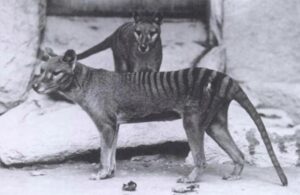|
Sometimes, it seems like science fiction becomes reality. That appears to be close at hand with de-extinction. The previous edition of Creation’s Corner considered the triad of extinction. De-extinction aims to bring species back to life that no longer exist. How in the world (and I really mean that) could an extinct species be brought back to life. Can it be done, and should it be done? When is the line crossed when we cease caring for creation and begin to “play the part of God”? Bringing species back from extinction has long been discussed as a dream. A possibility? We must remember that nearly all the thousands of species lost in the last few hundred years have been directly or indirectly due to humanity. Without us, most would continue their fruitful existence. How, then, would the process of de-extinction move ahead one species at a time? Candidate species currently include species where DNA extraction from their remains (sometimes fossils) is possible. Tyrannosaurus is not a possibility (at least at present). A short list that is being discussed includes the wooly mammoth, passenger pigeon, Thylacine (Tasmanian tiger), and the gastric-brooding frog. Let’s begin our discussion with the mammoth. Several frozen intact specimens have been found in the Arctic ice in Siberia and North America — some with grass still in their mouths, blood in their veins, and edible pink flesh. These specimens are more than 20,000 years old! A complete genome was sequenced in 2015. A simple outline of the anticipated steps to bring a mammoth back to life include inserting the mammoth DNA into the nucleus of the egg of an African elephant and implanting the egg into the elephant’s uterus. If the pregnancy of 22 months is successful, a mammoth would be born. How soon will this be done? In a 2021 interview with USA Today, Ben Lamm, CEO of Colossal Laboratories and Biosciences stated “…we still expect our first mammoth calves by 2028”. |
|
Will it be possible to bring some species back from extinction? I expect some reading this post will witness de-extinction in their lifetime. Imagine living with a woolly mammoth! However, will it be possible for the restored species to again become fruitful populations within Creation? For that to occur, it must have at least a minimum viable population. For vertebrates, that number is in the hundreds. Another problem is that species brought back from extinction – our woolly mammoth – would carry a single genome. There would be no genetic variability for adaptation to changing environmental conditions. A huge gap exists between a single individual brought back from extinction and a minimum viable population. The steward’s primary task today should be to protect and nurture Creation’s living species. Entering the daunting process of de-extinction will be a considerable challenge. — Joe Sheldon Thanks for listening. Direct comments to [email protected] If you would like to receive additional information on Creation care, notices of special events, Creation walks I lead, etc. don’t hesitate to contact me at the above address and I will add you to my e-mail list. Your comments are welcome. |



